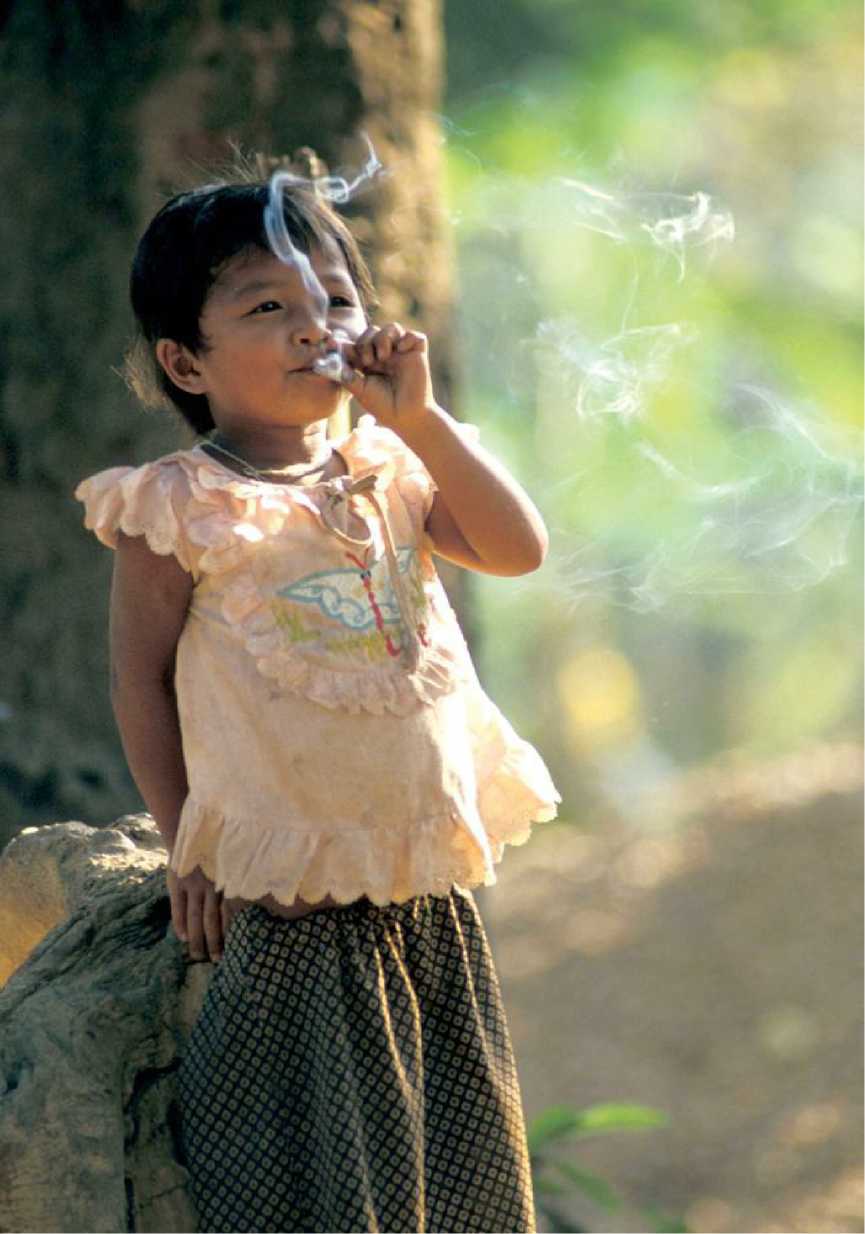Yet drug use is not inevitably destined to escalate forever. Just as cultures begin their drug habits without official permission, they can equally curtail them at their own initiative. Perhaps the most conspicuous example in the present day is tobacco: the very substance that, along with sugar, started the global drug trade. For four centuries, it has seduced the modern world via pipes and snuff, cigars and cigarettes, but in Europe and North America, where its global conquest began, the taste for it seems to be in decline. Tobacco has always been a social drug, an adjunct to meeting strangers, relaxing after work and sparking up conversations, a small gift that buys five minutes of informality and interaction, but now it is more commonly regarded as antisocial than convivial. During the Second World War, General Pershing famously declared that cigarettes were more important than food for troop morale; today, their packs are emblazoned with hideous images of emphysemic lungs. Throughout modernity, smokers have been the life and soul of the party; now they shiver on the street outside the office building, addicts isolated by their need for a fix.
This is, however, only the case for the Western minority. The global tobacco habit is far from being extinguished: in many parts of the developing world it is still spreading and the cultural attitude towards smoking remains very different. China, for example, where the cigarette first established itself as a modern substitute for the opium habit, is home to nearly a third of the world’s smokers, some 300 million; here it remains a symbol of wealth, conviviality and sophistication. An international brand marks a businessman out as a cosmopolitan ‘player’; an avant-garde artist poses with a cheap focal smoke. In Japan, which has maintained a proudl}' distinctive smoking culture since it developed its own kiseru style of tobacco around 1700, cigarettes are produced and advertised by the government-controlled Japan Tobacco corporation. Official government policy discourages non-smokers and the young from starting, but the firm’s statement of corporate responsibility includes ‘respect for focal norms and cultures’, and insists ‘we do not believe that there is a single, global “solution” to the tobacco controversy’.
The change in Western attitudes, though supported by governments and public health initiatives, is driven by the dawning realization that the risks of smoking, for those who would otherwise expect to live long and healthy lives, are on a scale that dwarfs any other mainstream form of consumption or leisure activity. Half of all lifetime users will die of their habit, meaning that it will kill half a billion people alive today. The demonstration of the link between smoking and lung cancer, made by Richard Doll in 1950, is potentially the most significant in the entire history of epidemiology, but it has registered more profoundly in some cultures than in others. In the modern West, its effect has been more pronounced among those of higher classes and incomes, and the drive to quit smoking has taken on the aspirational cast of the nineteenth-century Temperance campaigns against alcohol. The Western world has not abandoned the habit en masse - in absolute terms, the decline in the number of smokers has been modest - but the social status of smoking has moved sharply downmarket.
An important component of this change in social attitudes has been the redehnition of the smoking habit as an addiction to nicotine. Drinking coffee is not conceived as caffeine addiction, but tobacco is now seen as a ‘drug’ in the pejorative sense of the term, and its users pathologized as addicts; indeed, many smokers now prefer to justify their habit as an addiction rather than as a personal choice or a moral weakness. But the relation of nicotine to the dangers of smoking is a curious one. Although it is powerfully toxic in larger doses - the amount of nicotine in a packet of cigarettes, if eaten, would be lethal - the drug as smoked is not particularly harmful; it is the tars in tobacco that deliver both the taste and the carcinogens. This means that the drug can be its own remedy: nicotine patches and gums have become a hugely prohtable industry, a puritan substitution that turns poison into medicine by removing the element of pleasure. Nicotine is a useful stimulant, and the fact that it is harmless enough to be supplied pharmaceutically suggests that it may become popular in the future in a smoke-free form.
Although the new cultural attitudes to smoking are widely perceived as resulting from government controls and regulations, they are a broader response to the epidemiological evidence: the pressure to regulate emerged from public health and citizens’ groups long before any official diktats. From the seventeenth century onwards, national governments have almost universally adopted the strategy of raising as much tax revenue from tobacco as the market will bear, and it is now clear that, particularly in the United States, administrations and tobacco lobbies colluded for decades in obfuscating public health evidence in the interest of protecting their revenue streams. In the decline of smoking, governments and nation-states are the losers. Tobacco duties raise vast sums, are easy to extract and politically hard to oppose, even though they fall disproportionately on the poor, and although smokers place a considerable burden on health services, they also relieve them by dying
Sooner. The most significant political initiatives have taken place on the international stage, particularly through the World Health Organization, whose Framework Convention on Tobacco Control, which came into force in 2005, defines tobacco purely as a health problem - ‘the tobacco epidemic is a communicated disease’ - and mandates that nation-states reduce demand by regulating products, advertising, sales to minors and smoke-free zones.

The World Health Organization campaigns for pictorial health warnings on cigarette packs. (© World Health Organization 2009)

A young girl smokes a cigarette in Laos in 2008. (©Jim Holmes/World Health Organization 2009
I73r)
Yet if tobacco was nothing but a vector of disease and death, it could not have entwined itself into modernity as tightly as it did. Like all drugs, it offers benehts and extracts costs, in a ratio that varies between individuals and across cultures, and which is constantly adjusted over time. The ratio is markedly more positive in some substances than in others, but it can never be reduced to a dehnitive medical calculation: it is also determined by the forms and doses in which the drug is consumed, whether its trade is responsibly regulated or controlled by prohteers or criminals, and the ever-changing cultural spheres in which its use unfolds.
Tobacco has been called the shaman’s curse on the West, his revenge for the inequalities of the Columbian exchange: the most prized of his sacred plants turned out to be a poison chalice. But to the Native Americans, tobacco’s benehts were indeed great and its costs low, since most did not consume it at the levels of the habitual cigarette smoker, or live long enough to suffer its fatal consequences. For many across the developing world, the situation remains much the same today. It is in the wealthy enclaves of the West that the cost-beneht ratio has shifted most signiftcantly, though even here its health harms are less of a deterrent to the young; only with increasing age do medical concerns begin to outweigh the social pleasures of smoking. Broadly speaking, the decline of tobacco seems to correlate with higher levels of wellbeing, education and the prospect of living a long and happy life. If so, the Age of Tobacco ma}' be waning as science tips the scales decisively against it, but its twilight could still be a long one.




 World History
World History









